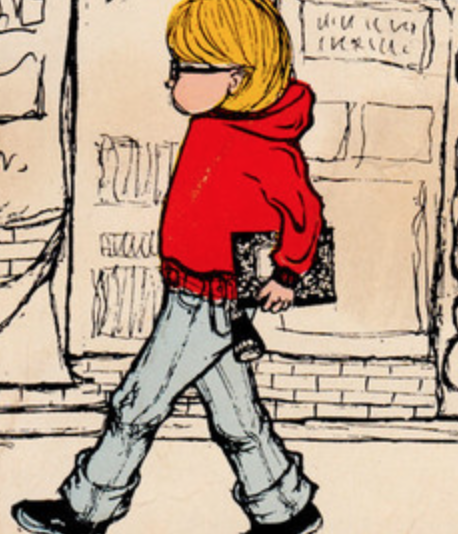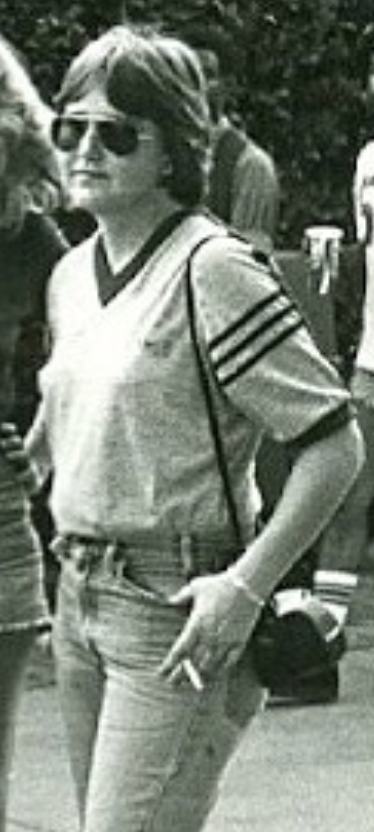 One very terrible summer, I was jobless, in the wake of a breakup, and looking at the wrong side of thirty-five. “I don’t know what to do with myself,” I told a librarian friend. “Read the Kinsey Millhone mysteries,” she said. “They’re bestsellers for a reason and there’s a ton of them.” By the summer’s end, lone-wolf private detective Kinsey had become my first fictional bestie since I’d ostensibly grown out of rereading Harriet the Spy at age 12. (I never really did.)
One very terrible summer, I was jobless, in the wake of a breakup, and looking at the wrong side of thirty-five. “I don’t know what to do with myself,” I told a librarian friend. “Read the Kinsey Millhone mysteries,” she said. “They’re bestsellers for a reason and there’s a ton of them.” By the summer’s end, lone-wolf private detective Kinsey had become my first fictional bestie since I’d ostensibly grown out of rereading Harriet the Spy at age 12. (I never really did.)
It’s no coincidence, that Harriet connection. Grumpy, idiosyncratic, and eminently decent, the subject of Sue Grafton’s bestselling alphabet series is the sort of tough-guy tomboy rarely found outside of children’s literature to all of our detriment. Like the love child of Mickey Spillane and Ramona Quimby, Kinsey suffers no fools and is only partially domesticated. Orphaned young, divorced twice, and child-free, she’s a former cop who prefers pickle and peanut butter sandwiches over salads, lifts free weights, cuts her own hair with nail scissors, and owns only one dress–a wrinkle-resistant black number for when she can’t get away with jeans and turtlenecks. Shacked up with a Japanese bobtail cat Ed in a garage apartment owned by Henry, her eighty-eight-year-old retired baker of a best friend, she regularly swills cheap white wine and frightening goulash at the local tavern with a handful of cops whom she sometimes dates and consults in the delightfully lo-fi world of 1980s Santa Teresa, a fictionalized Southern California town resembling Santa Barbara, where Grafton lives part-time.
Beginning with 1982’s A Is for Alibi, each novel in the series weaves Kinsey’s cases with developments in her personal life; aging one year every two and a half books, she is thirty-nine in 1989 in Y Is for Yesterday, the just-released twenty-fifth book in the series. Keeping the series in the Affluent Eighties means Kinsey takes notes on index cards, types reports on a Smith-Corona, tracks people offline, and, most happily, can play the rebel simply by leading a Spartan lifestyle among all those yuppies. This is convenient because, though she flouts social convention and occasionally fibs, the gumshoe takes pride in her code of ethics and keeps a tight ship in her home,  business, and physicality. Always a study in incongruities, this does not stop her from talking trash in a constantly running inner monologue, especially about other women’s garb: “She wore a pale-yellow sweater about the hue of certain urine samples I’ve seen where the prognosis isn’t keen.”
business, and physicality. Always a study in incongruities, this does not stop her from talking trash in a constantly running inner monologue, especially about other women’s garb: “She wore a pale-yellow sweater about the hue of certain urine samples I’ve seen where the prognosis isn’t keen.”
So is she an anti-feminist? No. But neither is she an obvious feminist. As a heterosexual woman who rejects most aspects of traditional femininity, has few female friends, and is most definitely not a woman hater, Kinsey is an unusual figure in contemporary fiction and in life, though hardly the hot topic she should be in cultural criticism. So should she be upheld as a role model?
That’s harder to answer, even if you’re asking Grafton herself. “It didn’t dawn on me that there were so few female private eyes,” she’s said, “But since my only area of experience was being a woman … I just created an alter ego and got to funnel all my bad language and irreverent thoughts into her …. Now I look like a hero, when in fact I was just being sassy.”
“Just being sassy” could be Kinsey’s motto, but the books never lapse into glibness. Instead, they lope along like a broad who doesn’t care what she looks like but still looks good. The whodunits are never impossible to solve, but each one packs a punch with crisp, clever prose and red-herring revelations. And while some complain the plots aren’t gritty enough, they balance Kinsey’s rough edges – the class resentment she harbors even when her bank account expands – with a core kindness that sees more of the light of day with each series installment. In short, Ms. Millhone is excellent company, a clear-hearted curmudgeon whose stories seem written right out of the side of Grafton’s mouth.  Because of this, I love listening to them on audiobook as much as I love reading them on page. Judy Kaye’s narration (she narrates most of the audiobooks, including Y) is exactly like the Kinsey in my head, which makes me fantasize about how satisfying an adaptation could be as well.
Because of this, I love listening to them on audiobook as much as I love reading them on page. Judy Kaye’s narration (she narrates most of the audiobooks, including Y) is exactly like the Kinsey in my head, which makes me fantasize about how satisfying an adaptation could be as well.
But don’t hold your breath for an onscreen Lady K. Grafton, who worked as a TV writer for fifteen years before penning her first mystery, has refused to sell the series’ movie rights. “I know how … the decisions are made,” she has said. “It’s like being picked up in a bar: If you really believe when the guy tells you you’re beautiful, you’re going to be in for a big surprise.”
Close your eyes, and she sounds just like my pal Kinsey.
This was originally published at Signature.
